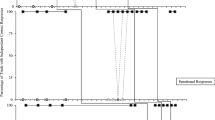Abstract
Mand training is often a primary focus in early language instruction and typically includes mands that are positively reinforced. However, mands maintained by negative reinforcement are also important skills to teach. These include mands to escape aversive demands or unwanted items. Another type of negatively reinforced mand important to teach involves the removal of a stimulus that prevents access to a preferred activity. We taught 5 participants diagnosed with autism spectrum disorders to mand for the removal of a stimulus in order to access a preferred item that had been blocked. An evaluation was conducted to determine if participants responded differentially when the establishing operations for the preferred item were present versus absent. All participants learned to mand for the removal of the stimulus exclusively under conditions when the establishing operation was present.
Similar content being viewed by others
References
Carr, E. G., & Durand, V. M. (1985). Reducing behavior problems through functional communication training. Journal of Applied Behavior Analysis, 18, 111–126. doi:10.1901/jaba.1985.18-111
Drasgow, E., Halle, J. W., Ostrosky, M. M., & Harbers, H. M. (1996). Using behavior indication and functional communication training to establish an initial sign repertoire with a young child with severe disabilities. Topics in Early Childhood Special Education, 16, 500–521. doi:10. 1177/027112149601600408
Duker, P. C., Dortmans, A., & Lodder, E. (1993). Establishing the manding function of communicative gestures with individuals with severe/profound mental retardation. Research in Developmental Disabilities, 14, 39–49. doi:10.1016/0891-4222 (93)90004-4
Lalli, J. S., Casey, S., & Kates, K. (1995). Reducing escape behavior and increasing task completion with functional communication training, extinction, and response chaining. Journal of Applied Behavior Analysis, 28, 261–68. doi: 10.1901/ jaba.1995.28-261
Lechago, S. A., Carr, J. E., Grow, L. L., Love, J. R., & Almason, S. M. (2010). Mands for information generalize across establishing operations. Journal of Applied Behavior Analysis, 43(3), 381–395. doi:10.1901/jaba.2010.43-381
Neef, N. A., Walters, J., & Egel, A. L. (1984). Establishing generative yes/no responses in developmentally disabled children. Journal of Applied Behavior Analysis, 17, 453–460. doi:10.1901/jaba. 1984.17-453
Reichle, J., Rogers, N., & Barrett, C. (1984). Establishing pragmatic discriminations among the communicative functions of requesting, rejecting, and commenting in an adolescent. Journal of the Association for Persons with Severe Handicaps, 9(1), 31–36.
Schuster, J. W., Gast, D. L., Wolery, M., & Guiltinan, S. (1988). The effectiveness of a constant time-delay procedure to teach chained responses to adolescents with mental retardation. Journal of Applied Behavior Analysis, 21, 169–178.
Shillingsburg, M. A., Kelley, M. E., Roane, H. S., Kisamore, A., & Brown, M. R. (2009). Evaluation and training of “yes/no” responding across verbal operants. Journal of Applied Behavior Analysis, 42, 209–23. doi:10.1901/jaba.2009.42-209
Sigafoos, J., Drasgow, E., Reichle, J., O’Reilly, M., & Tait, K. (2004). Tutorial: Teaching communicative rejecting to children with severe disabilities. American Journal of Speech-Language Pathology, 13, 31–42. doi:10.1044/1058- 0360(2004/005)
Sindelar, P. T., Rosenberg, M. S., & Wilson, R. J. (1985). An adapted alternating treatments design for instructional research. Education and Treatment of Children, 8, 67–76.
Winborn, L., Wacker, D. P., Richman, D. M., Asmus, J., & Geier, D. (2002). Assessment of mand selection for functional communication training packages. Journal of Applied Behavior Analysis, 35, 295–298. doi:10.1901/jaba.2002.35-295
Author information
Authors and Affiliations
Corresponding author
Rights and permissions
About this article
Cite this article
Shillingsburg, M.A., Powell, N.M. & Bowen, C.N. Teaching Children With Autism Spectrum Disorders to Mand for the Removal of Stimuli That Prevent Access to Preferred Items. Analysis Verbal Behav 29, 51–57 (2013). https://doi.org/10.1007/BF03393123
Published:
Issue Date:
DOI: https://doi.org/10.1007/BF03393123




